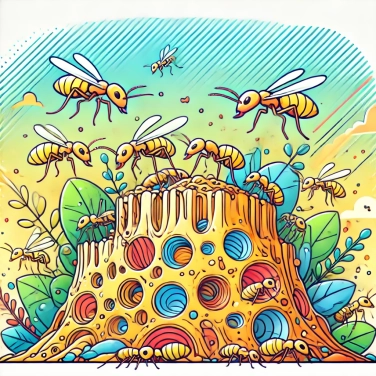Termites are considered natural architects due to their ability to build complex and functional structures, such as termite mounds, using local materials and their own saliva, thereby creating regulated environments for their colony.

Termites are construction pros: their mounds naturally follow several architectural principles that we use in our own buildings. For example, the slender and slightly conical shape of the mounds provides them with optimal stability against the elements. The tunnels and galleries inside follow an ingenious pattern facilitating ventilation and air circulation, allowing for temperature regulation without artificial air conditioning. Their structures also offer perfect management of spaces dedicated to different activities: food storage, nurseries, or areas designed to expel moisture and waste. All this is accomplished by instinct, without an architect or a qualified engineer!
In termites, it's all about teamwork. Each individual has a specific role, and cooperation reigns supreme: workers, soldiers, reproducers, each does what they are programmed to do. Termites communicate mainly through chemical signals called pheromones, allowing for perfect coordination without a leader. There is no strict hierarchy here; it's more about self-organization, as if everyone naturally knows what to do at the right moment. When it comes to building the termite mound, everyone has their task, but the effort remains collective. All of this leads to the creation of incredibly sophisticated and durable structures, without plans or a chief architect: just a really good organization.
Termites build their shelters using primarily simple but highly effective materials, such as saliva, soil, and their own excrement. Well, it's true, when put that way it doesn't sound very appealing, but their technique is top-notch: by mixing these elements, they create a kind of natural mortar that is super resistant to drought, weather conditions, and even predators. They then shape all of this into small pellets that are easy to stack, forming immense structures that can reach several meters high. And the cherry on top is their way of managing the tunnels: they are slightly porous, promoting good air circulation to ensure impeccable ventilation. Not bad for little insects without engineering degrees, right?
Termites build their mounds by incorporating a true system of natural ventilation to maintain a constant temperature and humidity inside. The principle is clever: the outer walls have a multitude of small holes and corridors that serve as air ducts. During the day, warm air rises and exits from the top of the mound, creating a suction effect that draws in cooler air from the bottom. This ingenious phenomenon, called the chimney effect, ensures that the temperature inside remains stable, even under scorching sun. Termites constantly adjust the size and opening of these air tunnels to adapt to external climate changes. In short: a highly efficient natural air conditioning system, tested and validated for millions of years!
Scientists and engineers are closely observing termite mounds to design sustainable and energy-efficient buildings. Some modern structures, like the Eastgate Centre in Zimbabwe, draw inspiration from the natural ventilation and thermal regulation system of termite habitats. This building manages to maintain a constant temperature without any conventional air conditioning, drastically reducing its energy consumption. The galleries and natural chimneys invented by these insects are now being studied closely to create eco-friendly ventilation systems in our architecture. One could almost say that termites have become the unexpected architecture teachers we didn’t know we needed.
Researchers are studying termite mounds to design more energy-efficient buildings, particularly ventilation systems directly inspired by these natural structures.
Unlike bees or ants, termites build their structures without having a prior plan or blueprint. A process based solely on communication and collective cooperation is sufficient for them to achieve these complex constructions.
Termites are capable of quickly repairing any damage done to their habitats, responding immediately as a team as soon as a breach is detected.
The ingenious structure of termite mounds allows termites to maintain a nearly constant temperature and humidity, despite extreme climate variations outside.
Termites mix soil with their enzyme-rich saliva to create an extremely durable and waterproof natural mortar. This combination hardens quickly, allowing for the construction of robust structures that can withstand the elements and predator attacks.
Yes, termites primarily use chemical pheromones, but also touch and vibrations to communicate and effectively coordinate their efforts. It is this sophisticated communication that allows them to act collectively and build such complex structures without a predetermined plan.
Engineers and architects have notably drawn inspiration from the passive ventilation system of termite mounds to design energy-efficient buildings, such as the Eastgate Centre in Harare, Zimbabwe. This structure utilizes the same natural principles of cooling and ventilation employed by these insects.
Yes, through their ingenious design and durable material, termite mounds withstand the elements, heavy rains, and numerous natural enemies. Their complex internal structure also provides effective protection against predators such as ants.
Species such as Macrotermes bellicosus in Africa build enormous above-ground termite mounds that amaze scientists with their thermal efficiency and complex structure. Additionally, termites of the genus Nasutitermes, found particularly in Australia, are famous for their ingenious hanging nests.

No one has answered this quiz yet, be the first!' :-)
Question 1/5